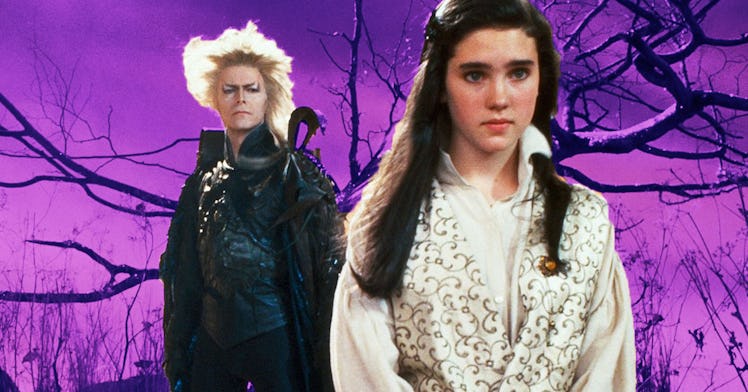The Darkest Jim Henson Movie Ever Is Finally On Netflix
Get yourself to the 'Labyrinth.'

If you’re anything like us, Sesame Street and The Muppets got you through the first year of COVID. Now, Jim Henson’s darkly bizarre 1986 classic film, The Labyrinth, has come to Netflix. And you should watch it, like tonight. If you’ve somehow never seen it, you really don’t know what you’re in for. Here’s why this cult muppet-adjacent classic is worth your time.
First of all, try to remember that children of the ’80s were deeply confused by this movie. I remember when, as a kid, we rented the VHS copy from Video2Go expecting, well, muppets. What we got was something else entirely–but something we went on to rent again and again, well into our teens. So don’t expect Kermit or Elmo: this is the Muppets through the mirror darkly and in the company of David Bowie and Jennifer Connolly. If, like me, you haven’t watched it since you were a kid: it’s a trip to revisit a world– and a feeling–that still occupies your subconscious. But if you’ve never seen, then you’re in for a treat–albeit a classic, strange, and of-it’s-time treat with song and dance numbers featuring goblin puppets.
What’s is Labyrinth about?
Labyrinth is a classic real-world meets fairy tale reality adventure in the spirit of Through the Looking Glass, The Wizard of Oz, or Where the Wild Things Are. Sarah (Jennifer Connolly), our teenage protagonist, is obsessed with playacting and make-believe. She lives half in the magical world of her books, and half in her bedroom’s surfeit of dolls and stuffed animals. In fairytale style, her mother is gone, and her father has remarried. One night, feeling wronged by her stepmother, and frustrated with her half-brother, she wishes that the Goblins of the play she was reading would come and take her brother away to the Goblin city. And thus the division between the real world and make-believe crumble and — no spoiler, cause it’s the whole thing — the goblins come and snatch him. She begs the Goblin King ( David Bowie) to return him; he gives her thirteen hours to solve the labyrinth that surrounds the castle. She sets off on a dizzying, circuitous adventure encountering a wild array of Henson-born characters. The film is speckled with David Bowie songs, including the infectious “Magic Dance.” Sarah finds herself navigating a world of broken rules, inconstant friends, and reality constantly rearranging itself — rich in its scenes and worlds, constantly rearranging itself. Her journey’s stakes are clear: to rescue her brother. But Sarah also finds herself confronting her own needs and wishes–and what it will mean if she is able to return to the real world.
Why do people love Labyrinth so much?
At the time it was released, Labyrinth did, like, awful at the box office: it made back only half its budget, and was pulled from theaters early. Most moviegoers — like my siblings and me later at the video store — went expecting the hijinks of The Muppet Show. The critical reviews were super rough, too. Movie critic Roger Ebert felt that The Labyrinth was just another nightmare movie–and he hated nightmare movies because they don’t have to follow any logic. “Therefore,” he wrote, since anything can happen to Sarah, “we’re wasting our psychic energy by caring.” Curiously, I think this is precisely the film’s power–why it’s stayed with folks. The film captures what many of us grown-ups have forgotten. Childhood is hella confusing: full of contradictions, unseen dangers, and a shifting landscape of rules. At sixteen, Sarah is on the cusp of adulthood. The film plays with the worlds both make-believe and real that teenagers (at least teenagers in the 80s) must reconcile. All the make-believe artifacts of Sarah’s childhood bedroom orbits a scrapbook of her absent mother, an actress. David Bowie’s Goblin King becomes a throughline of fascination and attraction: the promise of an escape from childhood into adulthood, however fantastic and problematic that might be… As critic Alison Stine notes, the “confusing and unnerving” quality of the Goblin King’s preoccupation with Sarah is also certainly part of what made the film resonate for young moviegoers. But, as she notes, also, a little creepy.
Weird Labyrinth trivia
Labyrinth is an embarrassment of richness in its easter eggs and inner connections. After watching the film once through, you should go back and re-watch the scene in Sarah’s bedroom to consider all the echoes and references that are planted there for us to hear throughout the film. While the exact meaning of these connections remains open, it’s wonderful to consider these breadcrumbs that Henson left for us.
The film owes much to the books of Maurice Sendak–and the version of childhood wonder and fright that he gives us in Where the Wild Things Are. Hensen credits Sendak as an inspiration, but it’s clear that Sendak’s story Outside Over There provided the DNA for the film (a girl wishes goblins would come to take away her brother and she has to go after him). If you look close, you’ll see copies of each of these books in Sarah’s room at the beginning.
Watching the film from our era of advanced CG, Labyrinth is a master class in technical special effects. The infamous “Magic Dance” scene featured over fifty puppeteers, forty-eight puppets/muppets, and actors in goblin costumes. At another point, when Sarah falls through a trap, she is caught by a series of hands — over one hundred latex gloves were used to create this wild scene. In addition, however, the film also features an early — if not the first — computer-generated character: the owl of the opening credits.
Finally, the baby in Labyrinth is Toby Froud. His parents are Wendy Midener and Brian Froud, artists who met while working on the Dark Crystal. You can read more about their amazing family story, right here.